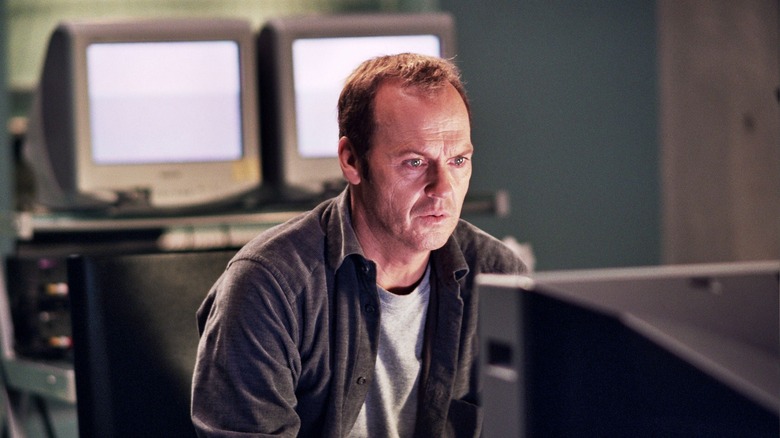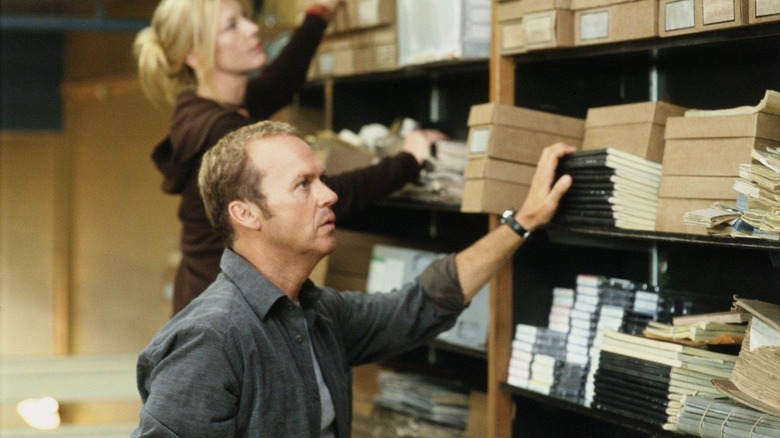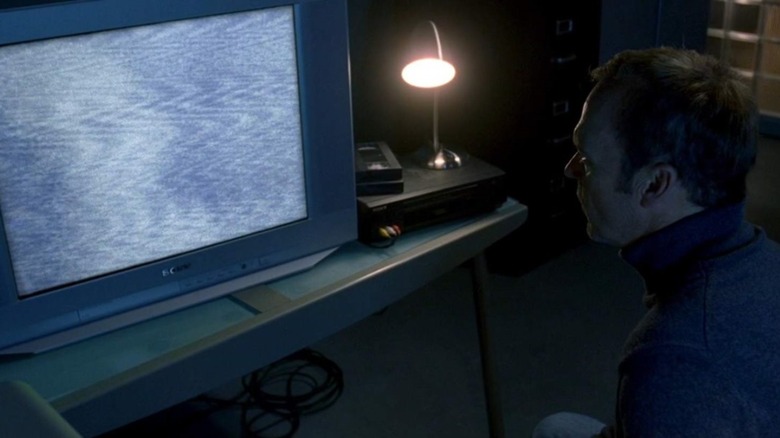In Geoffrey Sax’s 2005 thriller “White Noise,” Michael Keaton plays an architect named Jonathan Rivers (not to be confused with rocker Johnny Rivers) who is living in connubial bliss with his second wife Anna (Chandra West). One night, Anna doesn’t come home. She remains missing for five months. Jonathan is devastated, but holds out hope that she may still be alive. One day, he is contacted by a man named Raymond (Ian McNeice) who claims to have a clue as to Anna’s whereabouts. Raymond has been watching static-tuned TVs and listening to garbled radio signals, and claims he can hear voices emerging through the hissing. Raymond is convinced that the voices are the voices of ghosts, able to communicate with the land of the living through electrical signals.
Jonathan doesn’t believe Raymond at first, but soon falls under the spell of white noise monitoring. He finds that his monitoring is upsetting the denizens of the spirit world, and eerie, violent things begin happening to him. The story doesn’t end well for anyone. A chyron reads: “Of the many thousands of documented EVP messages, approximately 1 in 12 have been overtly threatening in nature…”
“White Noise” is based on a real-world field of paranormal study called EVP or Electronic Voice Phenomenon. Some people believe that the dead can indeed communicate through TV and radio static, and there have been episodes of “Sightings,” “The X-Files,” and other paranormal-themed TV shows devoted explicitly to EVP. Whether or not one believes in EVP, it’s definitely scary. Listening to a buzz or a hiss, and hearing an eerie human whisper randomly emerge, is enough to give anyone nightmares.
“White Noise,” however, didn’t connect with critics. On Rotten Tomatoes, “White Noise” only has a 7% approval rating, the lowest of any Michael Keaton movie.
The horror of old media
“White Noise” may count as another example of the horror fetishization of old technology. The idea is that older tech was built before the technology was refined, allowing the wilder parts of the paranormal world to infiltrate. A newer radio is too delicate and high-tech, the idea goes, to allow a signal from a ghost or a demon. A radio from the 1910s, however, has a vintage odor that makes it seem eerie, distant, and capable of something strange.
The same thing happened with VHS cassettes in films like “The Ring” and the 2019 film “Spiral.” Vintage tech is always going to be scarier. “White Noise” looks deep into the “snow” of a cathode ray tube TV and sees spirits lurking in the abstract shimmering. It’s a concept that fans of paranormal woo-woo were likely already familiar with, but director Sax presented it well enough.
Of the 149 reviews on Rotten Tomatoes, however, few were positive about “White Noise.” Christy Lemire, writing for the Associated Press, points out that white noise is also typically used as a sleep aid, and that the movie “White Noise” depends only on cheap jumpscares. She said it “is as tedious and repetitive as it sounds.” Nathan Rabin, writing for the AV Club, said that only Keaton’s performance kept the movie from being tittered off the screen. He wrote “EVP remains, to put it charitably, a sketchy phenomenon, but it’s a testament to Michael Keaton’s fine lead performance that ‘White Noise’ doesn’t come off as laughably preposterous.”
They weren’t all bad
William Thomas, writing for Empire, pointed out that “White Noise” was heavy on atmosphere, but thin in script, writing “The soundtrack and crackling static, contorting into mysterious moans, create a chilling mood, but the characters are so thin we never understand why Keaton would abandon his life for the paranormal.”
Not all the reviews were negative. Indeed, Stephanie Zacharek, writing for Salon, praised the film’s eerie mood. She noted that it wasn’t perfect, but that it ramped up to something truly scary. Zacharek wrote:
“It has plenty of problems — chief among them, the fact that the end doesn’t make much sense, and the first half crawls along on arty little ghost feet. But toward the second half, “White Noise” turns into something the first half doesn’t quite prepare you for — the movie takes on a dry, creepy sheen. Even if its dorky climax throws you out of the mood again, there are staticky bits of ‘White Noise’ that still manage to cling.”
Of course, one’s mileage from “White Noise” may vary depending on how scary you find eerie TV static. A generation of kids was raised on CRT tubes, and they all have the experience of peering into the static in a dark room, convinced that something is looking back. See also: “Poltergeist.” A more skeptical mind, of course, may just write off the conceits of “White Noise” as paranormal hooey, and reject the premise entirely.
As someone who has been terrified by a sudden voice emerging from an untuned TV, “White Noise” got under my skin a little. It’s not perfect by any means, and the story is a little silly, but it is what every horror movie ought to be: scary.





